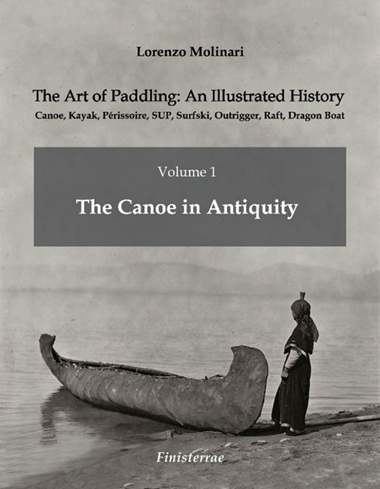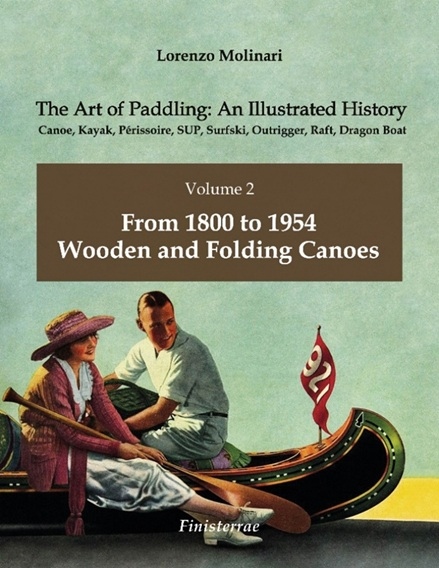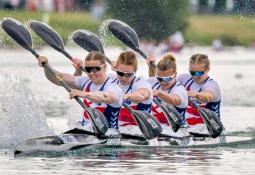A four-part series of books charting the history of canoeing from antiquity to the present day has been released.
“The Art of Paddling: An Illustration History” divided into four chronological volumes has been published with the aim of “filling a great cultural and editorial gap”.
Lorenzo Molinari, a long-time canoeing enthusiast, came up with the idea in 2017 to create a comprehensive historical series of books on paddling.
It was a mammoth project which took seven years for Milan-born Molinari to complete as he delved into archives, books, magazines, articles, videos, websites and blogs, as well as having interviewed many canoeists around the world to gather all the information he needed for the series.
“What surprised me most was discovering how complex and articulated the world of canoeing is and how little I knew about it, despite having practiced canoeing with passion for almost 50 years,” said Molinari.
“It is a great honour for me to have completed this research work, narrating the exploits and protagonists of our history.
“A history that was partly going to be lost, especially the oldest one, or to be diluted in the welter of the internet, since there is no book in the world that traces it from its origins to the present day.
“This work enhances our history, filling a great cultural and editorial gap, and debunking several commonplaces or false ideas about the history of the canoe.
“This work aims to create a cultural identity in the world of canoeing, which can only be achieved through knowledge of our history.”
Across the four books in large format, the Art of Paddling: An Illustration History comprises nearly 1,500 pages and 1,300 images with almost 2,500 names cited and nearly 2.6 million print characters.

Volume one, entitled “The Canoe in Antiquity”, tells the story of the first types of canoes used in the world from antiquity up to the beginning of the 1800s.
The book examines the origins and diffusion of many different types, including rafts, pirogues, canoes, coracles, royal barges, war canoes, outriggers, kayaks, périssoire, surfskis and Stand Up Paddling.
The construction techniques and materials used are also mentioned and the variety of boats belonging to each typology is illustrated in this book.

Volume two is called “From 1800 to 1954. Wooden and Folding Canoes” and looks at how in Western countries a new bourgeois social class with economic resources and free time began to travel for tourism and take up sporting activities, including canoeing.
One of the most extraordinary feats told in this book is German Franz Romer’s canoe crossing of the Atlanta Ocean in 1928 with his folding canoe propelled by a sail and a double-bladed paddle.
Volume two also looks at the organisation of the first flatwater and whitewater races with Canoe Sprint making its Olympic debut at Berlin 1936, and the foundation of the first National Federations and in 1924 the birth of the Internationale Repräsentantenschaft Kanusport which later became the International Canoe Federation.

“From Fiberglass to Polyethylene Extreme Feats” is the title of volume three in the historical series.
This book looks at the introduction of fiberglass in the construction of hulls which led to paddlers descending increasingly challenging sections of river and achieving epic feats.
Among those was the 1976 British Canoe Expedition, led by Mike Jones who descended the Dudh Koshi and set the altitude record in a canoe at 5,300m, paddling on the Lobuche, in the Khumbu ice at the base of Mount Everest.
Volume three also focuses on the advent of polyethylene which raised the threshold of extreme river descents even higher.

The last in the series is volume four, called “Rafting and Inflatable Canoes. Competitive Canoe and Champions”.
This book retraces the history of competitive canoeing with the boats used, the most famous manufacturers and the champions who have starred in the various paddling disciplines, including Canoe Sprint, Canoe Slalom, Paracanoe, Canoe Marathon, Canoe Freestyle, Canoe Ocean Racing, Canoe Polo, Wildwater Canoeing, Stand Up Paddling and Dragon Boat.
It also traces the history of rafts and inflatable canoes, particularly the exploits of those who first descended the Colorado River into the Grand Canyon.
“My hope is that this work will foster the development of a canoeing culture, making those who already practice canoeing more curious and enthusiastic and bringing even more people closer to this means of navigation,” added Molinari.
“There is no more beautiful gesture than paddling because paddling can also be an art and there is no better way to appreciate it than by knowing its history.”
The books are printed and distributed only by Amazon and are available in three formats – Kindle, paperback with flexible cover, and paperback with hardcover.
Related links




